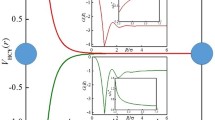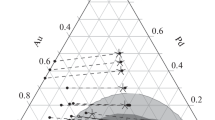Abstract
The hierarchical reference theory of fluids (HRT) is applied to the study of the phase diagram of binary mixtures of simple fluids. This approach implements the renormalization group machinery into a liquid-state theory in order to systematically deal with the effect of long-range correlations which play a crucial role in the onset of criticality and phase separation. The effect of fluctuations is embodied in a partial differential equation (PDE) for the free energy of the mixture. Recently, a robust numerical algorithm has been developed which enabled us to integrate this PDE on a substantial density mesh even at low temperature, when the coexistence region spreads over most of the density– concentration plane.We have considered a model mixture of spherical particles interacting via a hard-core plus attractive tail potential, and adjusted the particle diameters σ 1, σ 2 and the strengths of the attractive interactions ε 11, ε 22, ε 12 so as to mimic mixtures of simple fluids such as argon–krypton or neon–krypton. In the latter case the theory reproduces the occurrence of a minimum in the critical temperature (the so-called critical double point) and of immiscibility at high pressure. We have also studied the phase diagram of a symmetric mixture such that σ 1=σ 2 and ε 11=ε 22 as the ratio δ=ε 12/ε 11 is varied. In particular, we find that, in agreement with the mean-field picture, by decreasing δ, a critical endpoint occurring at equal species concentration is turned into a tricritical point. An interesting feature of the HRT is that, whenever phase coexistence occurs, the conditions of phase equilibria are implemented by the theory itself, without any need of enforcing them a posteriori. This allows one to straightforwardly map the phase diagram and the critical lines of the mixture.
Similar content being viewed by others
REFERENCES
See, for instance, J. S. Rowlinson and F. L. Swinton, Liquids and Liquid Mixtures, Butterworths, London, 1982.
A. Parola and L. Reatto, Nuovo Cimento D 6, 215 (1985).
L. Belloni, J. Chem. Phys. 98, 8080 (1993). J. S. Høye, E. Lomba, and G. Stell, Mol. Phys. 79, 523 (1993).
A. Parola and L. Reatto, Phys. Rev. A 44, 6600 (1991).
A. Parola and L. Reatto, Adv. Phys. 44, 211 (1995).
M. E. Fisher, Phys. Rev. 176, 257 (1968).
J. A. Schouten, A. Deerenberg, and N. J. Trappeniers, Physica 81A, 151 (1975).
N. J. Trappeniers and J. A. Schouten, Physica 73, 546 (1974).
C. K. Hall and G. Stell, Phys. Rev. B 11, 224 (1975).
E. Lomba, J. J. Weis, N. G. Almarza, F. Bresme, and G. Stell, Phys. Rev. E 49, 5169 (1994). E. Lomba, J. J. Weis, and G. Stell, Phys. Rev. E 50, 3853 (1994).
N. B. Wilding, F. Schmid, and P. Nielaba, Phys. Rev. E 58, 2201 (1998).
A. Parola, D. Pini, and L. Reatto, unpublished.
E. W. Grundke and D. Henderson, Mol. Phys. 24, 269 (1972). L. L. Lee and D. Levesque, Mol. Phys. 26, 1351 (1973).
See, for instance, J. P. Hansen and I. R. McDonald, Theory of Simple Liquids, Academic Press, London, 1986.
A. Meroni, A. Parola, and L. Reatto, Phys. Rev. A 42, 6104 (1990).
M. Tau, A. Parola, D. Pini, and L. Reatto, Phys. Rev. E 52, 2644 (1995).
W. F. Ames, Numerical Methods for Partial Differential Equations, Academic Press, New York, 1977.
J. A. Schouten, Phys. Rep. 172, 35 (1989).
A. Lotfi, J. Vrabec, and J. Fischer, Mol. Phys. 76, 1319 (1992).
H. M. Schaink and C. Hoheisel, J. Chem. Phys. 97, 8561 (1992). E. Z. Hamad, J. Chem. Phys. 105, 3222 (1996). The case of a mixture of non-additive hard spheres with equal diameters has been studied in detail by P. Ballone, G. Pastore, G. Galli, and D. Gazzillo, Mol. Phys. 59, 275 (1986).
C. Hoheisel and U. Deiters, Mol. Phys. 37, 95 (1979).
S. M. Foiles and N. W. Ashcroft, J. Chem. Phys. 75, 3594 (1981).
J. Kestin, S. T. Ro, and W. Wakeham, Physica 58, 165 (1972). J. M. Hellemans, J. Kestin, and S. T. Ro, Physica 71, 1 (1974).
G. J. Zarragoicoechea, O. H. Scalise, A. E. Rodríguez, and R. D. Gianotti, J. Chem. Phys. 91, 7130 (1989).
I. R. McDonald, Mol. Phys. 23, 41 (1972).
G. J. Zarragoicoechea and O. H. Scalise, J. Chem Phys. 107, 4358 (1997).
N. B. Wilding, Phys. Rev. E 55, 6624 (1997).
C. Caccamo, D. Costa, and G. Pellicane, J. Chem. Phys. 109, (1998).
D. G. Green, G. Jackson, E. de Miguel, and L. F. Rull, J. Chem. Phys. 101, 3190 (1994). E. de Miguel, E. M. del Río, and M. M. Telo da Gama, J. Chem Phys. 103, 6188 (1995).
Author information
Authors and Affiliations
Rights and permissions
About this article
Cite this article
Pini, D., Parola, A. & Reatto, L. Fluctuations-Inclusive Approach to Phase Transitions in Binary Mixtures. Journal of Statistical Physics 100, 13–38 (2000). https://doi.org/10.1023/A:1018657307050
Issue Date:
DOI: https://doi.org/10.1023/A:1018657307050




